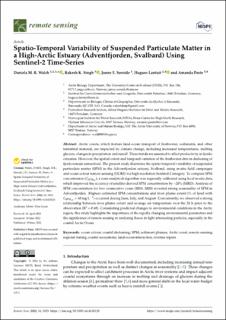Spatio-Temporal Variability of Suspended Particulate Matter in a High-Arctic Estuary (Adventfjorden, Svalbard) Using Sentinel-2 Time-Series
| dc.contributor.author | Walch, Daniela M. R. | |
| dc.contributor.author | Singh, Rakesh K. | |
| dc.contributor.author | Søreide, Janne E. | |
| dc.contributor.author | Lantuit, Hugues | |
| dc.contributor.author | Poste, Amanda | |
| dc.date.accessioned | 2022-10-25T05:18:14Z | |
| dc.date.available | 2022-10-25T05:18:14Z | |
| dc.date.created | 2022-09-13T12:26:59Z | |
| dc.date.issued | 2022 | |
| dc.identifier.citation | Remote Sensing. 2022, 14 (13), 3123. | en_US |
| dc.identifier.issn | 2072-4292 | |
| dc.identifier.uri | https://hdl.handle.net/11250/3028045 | |
| dc.description.abstract | Arctic coasts, which feature land-ocean transport of freshwater, sediments, and other terrestrial material, are impacted by climate change, including increased temperatures, melting glaciers, changes in precipitation and runoff. These trends are assumed to affect productivity in fjordic estuaries. However, the spatial extent and temporal variation of the freshwater-driven darkening of fjords remain unresolved. The present study illustrates the spatio-temporal variability of suspended particulate matter (SPM) in the Adventfjorden estuary, Svalbard, using in-situ field campaigns and ocean colour remote sensing (OCRS) via high-resolution Sentinel-2 imagery. To compute SPM concentration (CSPMsat), a semi-analytical algorithm was regionally calibrated using local in-situ data, which improved the accuracy of satellite-derived SPM concentration by ~20% (MRD). Analysis of SPM concentration for two consecutive years (2019, 2020) revealed strong seasonality of SPM in Adventfjorden. Highest estimated SPM concentrations and river plume extent (% of fjord with CSPMsat > 30 mg L−1) occurred during June, July, and August. Concurrently, we observed a strong relationship between river plume extent and average air temperature over the 24 h prior to the observation (R2 = 0.69). Considering predicted changes to environmental conditions in the Arctic region, this study highlights the importance of the rapidly changing environmental parameters and the significance of remote sensing in analysing fluxes in light attenuating particles, especially in the coastal Arctic Ocean. | en_US |
| dc.language.iso | eng | en_US |
| dc.publisher | MDPI | en_US |
| dc.rights | Navngivelse 4.0 Internasjonal | * |
| dc.rights.uri | http://creativecommons.org/licenses/by/4.0/deed.no | * |
| dc.title | Spatio-Temporal Variability of Suspended Particulate Matter in a High-Arctic Estuary (Adventfjorden, Svalbard) Using Sentinel-2 Time-Series | en_US |
| dc.type | Peer reviewed | en_US |
| dc.type | Journal article | en_US |
| dc.description.version | publishedVersion | en_US |
| dc.rights.holder | © 2022 by the authors | en_US |
| dc.source.pagenumber | 22 | en_US |
| dc.source.volume | 14 | en_US |
| dc.source.journal | Remote Sensing | en_US |
| dc.source.issue | 13 | en_US |
| dc.identifier.doi | 10.3390/rs14133123 | |
| dc.identifier.cristin | 2051173 | |
| dc.relation.project | Norges forskningsråd: 268458 | en_US |
| dc.relation.project | Norges forskningsråd: 296836 | en_US |
| dc.source.articlenumber | 3123 | en_US |
| cristin.ispublished | true | |
| cristin.fulltext | original | |
| cristin.qualitycode | 1 |
Tilhørende fil(er)
Denne innførselen finnes i følgende samling(er)
-
Publikasjoner fra Cristin - NIVA [2160]
-
Scientific publications [1172]

